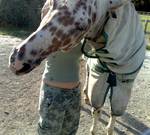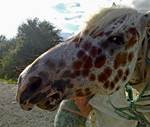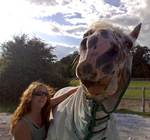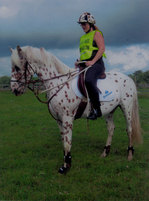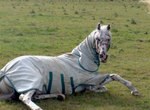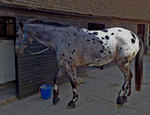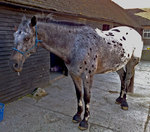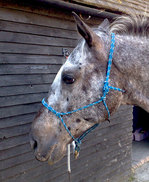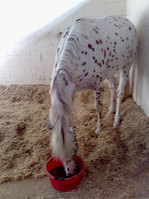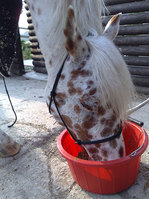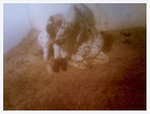Hi how sweet is this? Note how Rollo's upper lip jutts forward when he is being given a scratch - second photo shows that a treat. We call it his giraffe face! Thanks Pete for taking these!
Rollo is a very itchy horse and, very nearly, suffers from sweet itch (an allergic dermatitic reaction caused by a protein in the saliva of the biting Culicoides midge). Sweet itch can be a devastating condition resulting in sometimes such extreme pruritus that skin damage can result - the horse scratches its skin to try and rid itself of the persistent itching (often centered around the mane and tail areas) to the point of seriously exfoliating the skin at worst, and at best really messing with their mane and tail often losing a lot of hair in the process! So horse owners are very keen to try and wage war against said Culicoides midges, not only to save the horse agro, but also because the horse looks a mess if Culicoides wins! Also, they are bloody annoying to me too as they seem to like me! Bastards.
So I have had to be really careful as a result of Rollo displaying early signs of sweet itch - he goes out in a fly rug (or perhaps that should be called an "anti-fly rug") during the day because of that - you can see the rug in the photos. I also liberally spray him with fly and midge repellent, also wiping this around his face. The midges are most active during sunset and sunrise, but then there's all the othe nasty biting bastards around so at least he is protected from everything as much as possible!
Anyway, as a result - and anyway most horses do - he loves a good scratch and this is an important part of equine bonding rituals - that's why you will often see horses giving each other a mutual grooming session. Very often they start this by nibbling at one another's withers (the thoracic verterbrae for those friends of mind that don't know about horses; it is from where a horse's height is measured as it is the highest point of the back just below the neck). The withers are an easy trigger for endorphines (one of the body's "feel good" chemicals) which are released during this process and the horse also gets a dopamine hit! I remember many moons ago when I was a Pony Clubber doing Prince Phillip Cup and our "chef d'equipe" (!) told me to scratch the withers of my very excitable pony to chill him out - and it really did seem to take some of the stress out of him!
One of the things they get you to do in Natural Horsemanship (e.g. Pareli) is to rub your horse all over as a way of desensitization and bonding. I take this one step further because rubbing is great (why does all of this sound kind of pervy? It really isn't meant to!), but what many horses really want is a darned good scratch - done in a way to mimic a horse nibbling. I believe some of the techniques of the Tellington Touch technique also mimic this but then that is my opinion!
The moral of the story is if you spend a little while each day just scratching your horse then you become another horse to him - great bonding exercise. Even better, if you visit your horse in the field and give him a scratch for a while without any expectation of riding, you'll develop a bond to the point that your horse just walks up to you - no catching problems - the horse won't be associating you with work every time you enter his field! That's an old story but it works! Rollo always comes up to the gate for me, though sometimes I have to go a bit closer if he is asleep! And we even join in the other horses for grooming sessions which is very funny! So many people just grab their horse from the field, ride them and give them a perfunctory pat if they've done right and then bung them out in the field again. We *spend time* stroking and scratching our dogs and cats, so why not our horses?
Here's my tips for helping avoid midge and fly irritation:
- Keep the horse clean! Flies and midges (or not so much the latter) are attracted by dirt, sweat, secretions and coat grease. When your horse comes back from exercise, sponge off any sweaty areas. Make sure that you wash your horse all over regularly with e.g. Dermonline shampoo. When your horse has had a feed sponge off his nostril and muzzle area. Before you put your horse in the field, sponge off any secretions from his eyes/nostrils. This is a big thing to fight fly and midge annoyance.
- Use midge/fly repellent spray. If your horse doesn't like the feeling of the spray (or the noise of it), simply spray it on a sponge and sponge him over with it! Make sure to sponge his face with the repellent and the dock and sheath areas. Citronella was what I used to use but I think it is not licensed for use any more - but it used to be brilliant! Be aware that just as worms get immune/desensitised to certain anti-worming chemicals (anthelmintics) that so can flies and midges get used to spray - so use different ones from time to time.
- Use an anti-fly (usually just called a "fly") rug. Get one that also covers the dock and neck area. Be wary of using one that covers the face unless you really need to - would you like something covering your face and impeding your vision (especially if you are a prey animal like a horse)? I don't use a face mask on Rollo for this reason, but am vigilant about using facial fly spray and keeping his face clean. However, if you notice undue discharge from eyes, it may be due to fly irritation and you may need to re-consider this position and apply a mask because conjunctivitis may result and you will save vet bills on if you have to get something like chloromycetin.
- Don't stable or field your horse too near to water, muckheap, etc - if you have a lake/pond this is where midges breed, and muckheaps are a favoured choice for fly breeding! Horse flies in particular love water. Water buckets are better than fixed troughs. If you've got a fixed trough have a look in it in about Jun/Jul - see all those little wriggly things in there? Many of those will be midge larvae!
- When you are out riding, the midges and flies will also be attracted to you. The sprays you used on your horse may have masked them, but if the midges/flies get attracted to you, they may nevertheless get attracted to your horse as you ride him. So use a masking agent - e.g. Jungle Spray! It also avoids those bloody painful horse fly bastards that I hate as I come up in massive hives! Many people also recommend Avon's Skin-So-Soft Soft and Fresh Dry Oil Body Spray - it doesn't contain nasty chemicals but apparently creates a layer on the skin that midge mouthparts find hard to penetrate! Thanks for reminding me of that one, Frank (recommended to us when we were on the highly midgy Isle of Skye in Scotland in May this year). You can get the at Avon and doing a search on Google for "skin-so-soft" add "horses" to it and you'll find that some people even use it on their horses!
As a last comment, the number of Culicoides midges appear to be becoming increasingly prevalent in the UK, as does the length of their survival. Global warming is most likely to be the culprit. Hence the increase in the occurrence of sweet itch over the last several years. However, sweet itch aside, there is another, more sinister, reason for us all to become more vigilent about protecting our horses from midge bites and that is that the UK and northern europe are now for the first time being faced with diseases that were once termed "tropical". African Horse Sickness (and Blue Tongue virus which affects ruminants, e.g. cattle) are also carried by Culicoides midges and these diseases are spreading northwards. African Horse Sickness is really nasty and almost always fatal, so we all need to be even more vigilent to protect our horses from biting midges.
Hope that this is useful! Enjoy!
